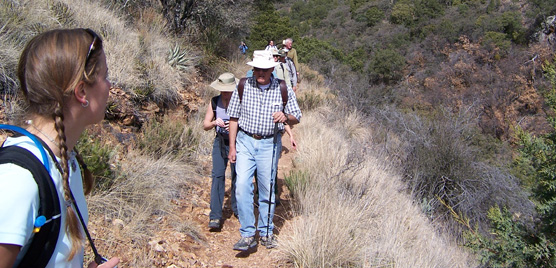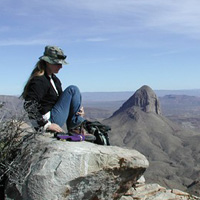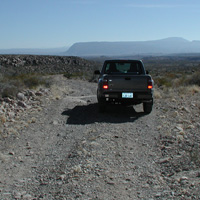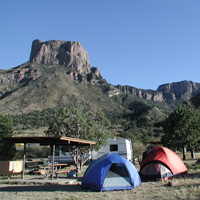 |

|
| NPS/Eric Leonard |
| Hikers on the Boot Canyon Trail. |
|
When President Franklin Roosevelt signed the bill authorizing Big Bend National Park on June 20, 1935, could he have imagined how popular the park would become over the next half-century? According to the enabling legislation that created the park, Big Bend National Park was set aside and protected for its “scenic and recreational values." Once a remote and seemingly inhospitable area reached only by miles of dirt road, Big Bend has become one of the most popular vacation destinations in the state of Texas, visited by an average of 300,000 visitors each year. Scenic vistas, diverse wildlife, historical sites, and the border culture all rank among the features that visitors enjoy in Big Bend, but the primary reason that many visitors give for visiting the park is the opportunity for outdoor recreation. Over 800,000 acres of open land invite you to explore, wander, and linger. Over 150 miles of dirt roads and about 200 miles of hiking trails wind through the park, providing almost limitless opportunity for hiking, camping, mountain biking, horseback riding, and other backcountry adventures. Additionally, the Rio Grande borders the park for 118 miles, giving river runners the option of floating canyons or open water by raft, canoe, or kayak.
 |
| Joe Sirotnak | | A hiker contemplates the desert |
 |
Hiking and Backpacking
Hikers who really want to experience the three major ecosystems of the park will want to hike trails in the Chisos Mountains, in the desert, and along the Rio Grande. The Chisos Mountains, lying in the center of the park, provide about twenty miles of hiking trails and forty-two campsites for backpackers. Rising to 7832 feet in elevation, the Chisos Mountains preserve a relict forest of oaks, pines, junipers, madrones, and Arizona cypress that provides a pleasant, shady hiking area year-round. Emory Peak, the highest point in the park, provides a panoramic view of the Chisos Mountains and the desert; the view from the South Rim extends far into Mexico on a clear day. It is not uncommon for hikers to see the tracks and scat of black bear, mountain lion, and gray fox along mountain trails. Carmen Mountains white-tailed deer, rock squirrels, rusty-rumped whiptail lizards, spotted towhees, tufted titmice, and Mexican jays are also common in the Chisos Mountains.
The Chihuahuan Desert covers about eighty percent of the park, surrounding the island of the Chisos Mountains like a desert ocean. Trails in the desert range from short, easy nature trails to multi-day treks marked only by rock piles, if at all. The remote desert routes provide a wonderful wilderness experience for experienced backpackers. Silence and solitude are key resources protected here, as there are few other places like this where people can escape civilization so completely. Quite often, the only sounds you hear are the wind and your own breathing. Bare rocky ground and sparse vegetation are hallmarks of the desert, but the observant hiker will find plenty of life here. Look for termite nests built up along the stems of plants, white exoskeletons of millipedes long dead, piles of animal droppings, and tunnels dug into the soil by rodents and reptiles. Bird life is plentiful in the desert, especially in the morning; look for nests hidden in yuccas, cacti, and other prickly vegetation. Hikers who roam the desert in the spring will find wildflowers adding their colorful blooms to the desert landscape. Bluebonnets, paintbrushes, bi-color mustard, desert bailey, yucca, ocotillo, and various types of cactus are some of the more obvious plants found blooming during the spring; a careful observer will find many more.
The Rio Grande creates yet another distinct environment in the Big Bend. Dense stands of reeds and mesquite thickets line the river for much of its length along the park boundary, making human access to the river difficult, but providing habitat for many types of wildlife. The best way to enjoy this area is from the river itself, but a short walk into one of the river canyons or elsewhere along the shore will show you a world very different from the rest of the park. A myriad of bird species can be found in the riverbank vegetation. As the river provides water for many desert animals, look along the muddy shoreline to identify who has visited it recently.
|
 |
| Sharon Collyer | | Loading the canoes |
 |
River Trips
Floating the Rio Grande can take you through miles of canyons up to 1,500 feet deep, where the sunlight may reach the bottom only briefly on winter days. Canyon wrens call from the high cliffs, and cliff swallows dart in and out of their colonies of mud nests. Sounds echo, magnifying the noise of rapids to make them seem much larger than they really are. The constant hiss is caused by silt in the water brushing against the bottom of your boat. The geologic history of the canyon walls is laid bare by eons of carving by the river, making canyon trips especially interesting for geologists.
Along the more open areas of the Rio Grande, you may see local people fishing, farming, and engaging in other traditional activities. These quiet stretches of the river offer expansive views of the colorful buttes, mesas, and mountains in both the U.S. and in Mexico. Far fewer people float the open water between the canyons, so it is possible to go for days without seeing another boater.
As in other parts of the park, your ears may tell you more than your eyes. Listen for beavers crawling through the brush, and you may see one slide down the riverbank into the water. Turtles, especially red-eared sliders, often sun themselves on rocks and logs just above the waterline. Great blue herons and green kingfishers are just some of the many birds you may see flying along the river.
|
 |
| Doug Duncan | | Driving the Glenn Springs Road |
 |
Backroads
The many miles of dirt roads in Big Bend National Park will lead you across washboards and boulders, through canyons and creekbeds, past old settlements and cemeteries. As an end in themselves, or as a means to access hiking trails or the river, the backroads may also test your vehicle and your driving skills. These roads are not for those who want to keep their expensive four-wheel-drive vehicles in pristine condition, but for those who wish to leave the blacktop behind and experience the park more slowly and intimately. The apparent monochrome of the desert separates into many unexpected hues as your slower driving pace provides a more close-up view of the desert vegetation. Several of the dirt roads provide excellent vantage points to see the looming South Rim of the Chisos Mountains change color throughout the day.
Mountain bikers are encouraged to explore the backroads as well. Although bicycles are not allowed on trails or off-road, the backroads offer sufficient challenge to most cyclists. Mountain bikers have some advantages over motorists on some stretches of particularly rough backroad, as it is easier to pick a route for one set of wheels than for two, and they always have the option of getting off and walking through or around the rough spots.
|
 |
| Doug Duncan | | Chisos Basin Campground |
 |
Camping
What’s a full day of exploring Big Bend without a night out under the stars? Big Bend offers a variety of camping experiences, regardless of your means of travel. For those who want to camp with some degree of civilization, the park maintains three developed campgrounds with individual sites, charcoal grills, picnic tables, water, and restrooms. For those who don’t mind having close neighbors, these campgrounds are the most convenient.
Visitors also have a number of primitive camping options. A backcountry use permit, available at a visitor center, is required. Over seventy primitive roadside campsites line the park's dirt roads; what these sites lack in amenities, they make up in scenic views. Many campers request specific sites based on the sunrise or sunset views visible there. Many of these backroad areas are single sites, giving campers a private camping experience.
Backpackers in the Chisos Mountains can choose from forty-two designated campsites. Some are surrounded by trees deep in Boot Canyon, while others lie in fairly open Laguna Meadow. Some are perched high near the South Rim, while others sit lower and closer to the trailhead. Some sites have spectacular views, while others are more sheltered and protected. Backpackers in the desert have the freedom to choose their own campsites in open zone areas, as there are no designated sites for backpackers there, but it can be a real challenge to find a flat, clear spot large enough to accommodate a sleeping bag. The desert may look barren from a distance, but you’ll find a surprising amount of vegetation when you try to find an open area for a campsite.
With few exceptions, river runners can camp almost anywhere along the Rio Grande. Like desert backpackers, they can select their own campsites, although sheer cliffs and dense river cane limit the camping options in many areas.
Regardless of where or how you camp, you’ll find that sleeping out adds another dimension to a trip to Big Bend. Camping distills our lives to the bare elements of living: finding a campsite, preparing a simple meal, laying out a bedroll. Sleeping out sharpens our senses, as we strain to identify every odd sound around our campsite. With no walls or ceilings in the way, campers witness nature firsthand. The changing colors of the Sierra del Carmen at sunset, the rising of the full moon, the rumbling of the Rio Grande, a chorus of coyotes, and a night sky sprinkled with thousands of stars are just a few of the rewards bestowed on those who camp out. And few experiences compare with waking up to a desert sunrise, with birdsong the only sound you hear.
|
|
There are as many ways to enjoy Big Bend as there are people who visit. The diversity of recreational options here offers something for almost everyone. People come to the park seeking escape, entertainment, exercise, and many more intangible things. Some go for multi-day treks, while others prefer to relax. Some visit to test their limits, while others come to recharge their batteries. Some visit the park alone, to reach and reclaim an inner peace, while others come to bond with family and friends. Some bring mountain bikes and kayaks, while others bring lawn chairs and novels. Talk to any of these visitors, however, and you’ll find that they have one thing in common: they’ve all found the type of recreation they were looking for in Big Bend National Park.
|
|  |  |

|
 |






